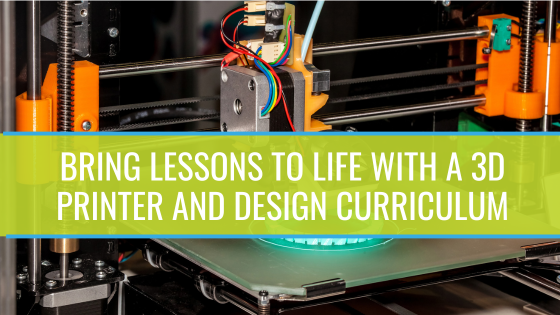Engineers have been working on 3D printing for decades, but only in the last 10-15 years has the technology become viable for educational settings. Since its introduction to schools, 3D printing has become a powerful STEM-teaching tool. Ideal for makerspaces and labs, but small enough for classrooms, there are many 3D printers for schools to choose from.
That’s exciting for educators, but also intimidating. Don’t worry, though, because this guide will help your school get started on 3D printing.
How 3D Printing Supports STEM Learning in K-12 Schools
The best STEM tools are those that can be used with students of all ages, with lessons that engage appropriately by age level. And few STEM technologies engage like 3D printers do. How can they benefit your K-12 students?- Elementary students - For younger students, 3D printing is an exciting novelty that can be used to exercise student creativity and problem-solving capabilities. Elementary students also learn how to utilize trial-and-error learning and are required to show patience while the printer works.
- Middle school students - At this age, students can channel their creativity through the 3D printer more effectively. In fact, some will begin their future engineering, design, scientific, or manufacturing career by familiarizing themselves with the technology at this stage.
- High school students - High school students can begin professional-level training with access to a 3D printer. They can take on complex, hands-on projects that will introduce them to the design cycle involved in product creation. This tactile approach to learning engages students in a way that most other lessons don’t, allowing schools to bring out the latent talents from more of their student body.
High school students can take the skills and critical thinking picked up through 3D printing and apply it to their studies at a trade school or university.
There are applications for 3D printing from K to 12, so the question isn’t if a 3D printer makes sense for your school. The real question is what features to look for in a printer.A Few Features to Consider for a 3D Printer
It wasn’t long before manufacturers started producing 3D printers specifically for education. These models, like the Robo E3 and Robo E3 Pro, come with features that enhance their safety and usability for both teachers and students. Those features include:- Enclosed printing spaces and HEPA filtering technology - Safety is the number one concern in schools and educational 3D printers prioritize it. Such printers are designed with enclosed printing spaces, so curious hands don’t wander around the print head. They’re also designed with HEPA filtering to remove any volatile organic compounds (VOCs) from the air during printing.
- Compatibility with other educational technologies - Educational 3D printers are designed to be used in conjunction with other technologies found in the classroom. For the most part, this means compatibility with various tablets and computing devices, so the printer can be accessed from a variety of devices. The Robo E3, for instance, can be controlled from a tablet and ordered to print from a file retrieved through the cloud.
- Simple out-of-the-box design that allows for immediate usage - Once educators and students are comfortable with the 3D printer, it can be used in a huge variety of projects. Getting comfortable is the challenge, though, but educational printers are designed with a gentle learning curve for schools. The Robo E3, for example, is a turn-key piece of technology that prints right out of the box.
Is 3D Printing a Big Tech Jump for Teachers? Consider a Curriculum Plan
Even if your teachers are experienced in STEM learning, it’s not easy developing curriculum for a 3D printer. With their limitless making capabilities, it can be overwhelming figuring out what to focus on for students. This is another reason to pick a 3D printer designed with education in mind. These printers are packaged with lesson plans and ideas that can get instructors started with zero prior knowledge. The Robo E3 and Robo E3 Pro, for example, come with curriculum plans that include the following:- Detailed lesson plans, some 10+ pages in length
- Compliance with academic standards
- Student assessment checks and quizzes
- Teacher guides
- 3D print files and instructions for assembly
- Paper handouts for students
Your Certified AV Integrator Can Help Your School Select the Right 3D Printer
A 3D printer may be a significant investment for your school. If it is, working with a certified AV integrator ensures you get the most from that investment. A certified integrator can match the right printer to your needs, taking the following into consideration:- The age group that will be using the printer
- How comfortable teachers are with 3D printers (and tech, in general)
- The type of room the printer will be used in
- How often the printer will be used
- What the printer will be used to make
- What other educational technologies are already in place



